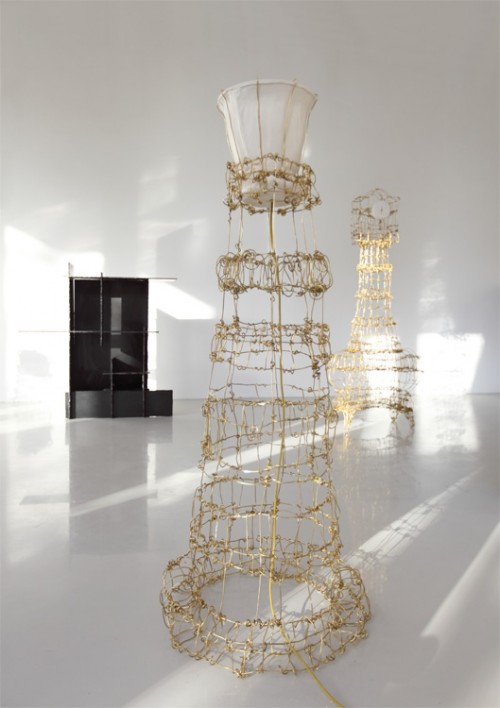
An article from Make magazine speaks of these fairly amazing clothing creations as being modular and composed of smaller fabric components that are connected into spectacular articles. (I’d like to post more of each of these designer’s works but the world of hip flash sites precludes me from linking to them so I’ll just steal the images from Make to frame my ramblings…). Being someone who kind of geeks out on generative works, I can certainly see a parallel in these creations, and that makes me pretty excited. Just like a lot of parametric works, these seem to talk of a very interesting future that’s tantalizingly just around the corner. Aside from a handful of strong examples, most seem to be still at the proof of concept stage. I often wonder when programmatic design will grow up and leave the experimental designer’s eye and land in the laps of the commoners like myself.
I’ve seen my share of installations that point to proficiency in constructing form and the usage of space. There certainly are pavilions and other simple, essentially utility-free structures shaped with such procedures, but still the honed wisdom of machine thinking hasn’t really found its home in everyday production of items. It’s as if there is a missing bridge between theory and practice that’s just too shaky to cross. I am not sure if it’s from the simple lack of patronage or if it’s an issue of maturity in the process.

Bringing this back to the modular clothing, I think these examples (and further on each of the designers pages) are some of the best that have crossed that shaky bridge of thinking and into utility. The shawl at the top of this post is perhaps the closest example to everyday usage and makes me excited to see where Eunsuk Hur takes her concept next, while Galya Rosenfeld‘s dress above holds its own in a high-fashion sense.
The idea of using small components of materials like this to create larger works would go a long way to using the overage from standard textile production processes. It would interesting to see if one could hone the methods that these designers use specifically to the tailings of large textile manufacture’s patterns, creating a sort of symbiotic relationship of efficiency. The shapes of the non-used portions could even be made available for modular colthiers to build off of as most patterns are now machine cut, creating perhaps a secondary market for the dross.
Maybe the way to bring the parametric world to the rest of us is through manufacturing efficiency? Using the capabilities of machine thinking and clever programming to use all the left-overs from primary processes. Could this be done with other industries? could one make sun shades perhaps from the cut-offs from the making of automotive body panels?
Until this is realized, make me a scarf, Eunsuk, it gets cold here in the midwest and I’d like to look cool when it is!






















